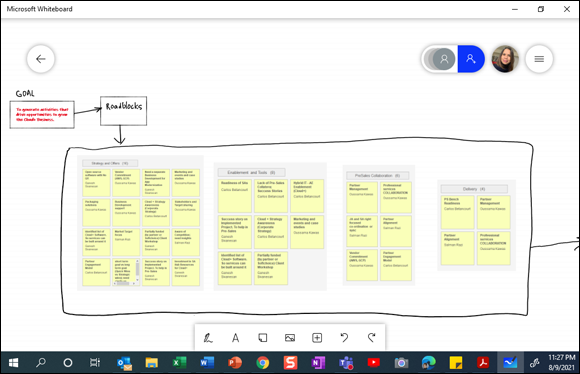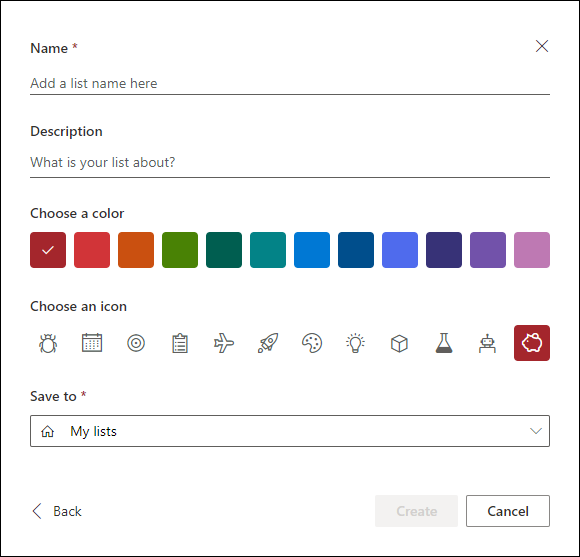Chapter 21
Ten More Apps that Get the Work Done
IN THIS CHAPTER
![]() Looking at the supporting characters — err, apps — in Microsoft 365
Looking at the supporting characters — err, apps — in Microsoft 365
![]() Creating your next (or first) website with a PowerPoint-like app
Creating your next (or first) website with a PowerPoint-like app
![]() Discovering the many ways to track lists and tasks
Discovering the many ways to track lists and tasks
If I were to write a chapter for every app that came with Microsoft 365, this book would never end. As a cloud service, Microsoft 365 continues to evolve — existing apps are updated, outdated ones are retired, and new apps are added. Even while writing this book, I had to regularly check the Microsoft Roadmap for updates and changes in case they might impact what I’m writing about. The last time I checked, there were 21 changes within the past week.
While the focus of this book is on the key productivity apps and functionalities typically used in the workplace, that doesn’t mean the rest of the apps in the service are not important or useful. The reality is you’ll inevitably come across these apps while you’re using the main workloads such as Teams.
To get you started in expanding your familiarity with Microsoft 365 world, here are ten additional apps that get the work done in the modern workplace.
People
When was the last time you had to spend precious minutes searching for an email from a coworker that you saw come in, for example, on Day 5 of a ten-day vacation and is now buried in your bloated mailbox? For me, that was yesterday.
The good news is, there’s a better way to find email from specific people without having to wade through replies and replies to all and CC and BCC emails. That better way is the People app in Microsoft 365, which can be accessed from the list of apps at the Microsoft 365 portal (www.office.com/apps) or directly at https://outlook.office.com/people.
To get the most out of the People app, it pays to add people to your contacts list. Contacts can be within or outside your organization. You can add people to your contacts list by clicking the New contact button from the web app at https://outlook.office.com/people. The other way is to hover over the sender’s name on an email until you see the contact card pop up. To the right of the contact card, click the More options (ellipses) icon and then click Add to contacts.
When you click on a contact in the People app, a contact card displays with an easy way for you to quickly send an email or start a chat. Aside from basic contact information, the contact card for people within your Microsoft 365 organization includes coworkers’ professional background information in the About tab, their reporting structure under the Organization tab, the documents they’ve shared with you in the Files tab, the emails they’ve sent you in the Email tab, and, if available, their LinkedIn profile in the LinkedIn tab.
So stop scrolling through your inbox looking for an email and instead check out the Email tab from your contacts in the People app to save you some time.
MyAnalytics
Do you feel like you’re spending too much time at work and yet you’re not getting a lot done? If so, you may not be getting enough uninterrupted time to focus on your tasks aside from attending meetings and responding to email.
Are you losing touch with the key people in the organization you need to be closely aligned with for your projects? If yes, then you may be working with too many people and thus aren’t able to keep track of the contacts that are critical for your success.
Especially in the world of remote work, are you finding time to disconnect and recharge? Or are your days simply starting to merge between your personal and professional lives to such an extent that it’s impacting your well-being? If you are, know that you’re not alone.
The challenges I’ve mentioned here are some of the insights you’ll glean from the MyAnalytics app in Microsoft 365 portal (www.office.com/apps) or directly at https://myanalytics.microsoft.com.
The statistics and insights from the app are collated from your email and calendar items, your interaction in Teams, and data from SharePoint and OneDrive. What you see in MyAnalytics is for your eyes only. Your manager or the IT admin cannot see what you see.
The insights you find are great but for them to be useful, you need to act on them. So if you’re finding that you’re sending email or working on documents outside of normal working hours, click the Wellbeing link from the left menu and then click View Suggestions from a card that displays it.
Kaizala
You know how people used to say, “Knowledge is power?” That really needs an update to “Access to data is power.”
With the growing concern about data privacy and security, companies are wary about having their employees use third-party mobile messaging apps for communicating and collaborating.
Enter Kaizala, the mobile chat app for the workplace that answers the need for security and privacy. With the app, employees can message people within and outside the organization using an Android or iOS device while allowing the company to keep ownership and control of the data backed by the security and compliance pillars in Microsoft 365.
There are many uses for Kaizala in the workplace. A ticketing system is one of them. For people who are used to the simple instant messaging experience, however, Kaizala offers a welcome break from the formal, structured Teams interface. It has started to gain adoption momentum and already has a growing community of users who collaborate in a “Group” via a persistent chat. Some of the larger community Groups right now are Hindi Motivation, and topics are digital marketing and artificial intelligence. There are also light-hearted groups like Comic Overload where users post a lot of vintage comics.
Want to discover what’s in store for you in Kaizala? Download the app from your phone’s app store, set it up with your mobile phone number, and then link your Microsoft 365 account to the app by tapping the Profile icon and then tapping the Linked Accounts menu. Once you’re logged in and set up, tap the Discover button to find what Groups await you.
Stream
If TED Talks is the thinking man’s YouTube, then Stream is the workplace’s TEDTube because the app can be both entertaining and informative while driving employee engagement which in turn increases productivity.
How-to videos, meeting recordings, sales pitches, and other types of video content can be stored as Stream videos powered by the intelligence and security available in the Office apps.
As with other apps in Microsoft 365, you can access Stream from the portal at www.office.com/apps or directly at https://web.microsoftstream.com or by downloading the mobile app from your device’s app store.
Whiteboard
When words don’t quite do the trick during a brainstorming session with your project team, drawing on a piece of paper or whiteboard can be an effective way to express your ideas visually.
In a virtual collaboration scenario, Microsoft Whiteboard is the tool you need to draw your vision. As a digital canvas, Whiteboard allows you to draw with your mouse, stylus, or your fingers on a touch screen using the same pens in the inking capabilities in the Office apps. While whiteboarding, you can add text, sticky notes, or graphics, and insert other types of content.
You can invite others to join the whiteboard and co-create in real time. Figure 21-1 shows a Whiteboard artifact from a brainstorming session I conducted with my team.

FIGURE 21-1: A Whiteboard artifact.
Whiteboard is available as desktop or a web app. To download the desktop app, visit the following link:
www.microsoft.com/en-us/microsoft-365/microsoft-whiteboard/digital-whiteboard-app
The web version can be accessed from the Microsoft 365 portal at www.office.com/apps or by going directly to https://app.whiteboard.microsoft.com and logging in with your Microsoft 365 credentials.
Lists
What do you get when you combine simple, smart, and flexible? You get Microsoft Lists, a productivity solution for organizing work, tracking information, and keeping project team members on the same page.
Lists are simple. You can save time by using free templates or start from scratch by providing a name for your list, the description, choosing a color and icon, and deciding where to save it (see Figure 21-2). You can also import an existing list from Excel!

FIGURE 21-2: Starting a list from scratch.
You don’t even have to be one of those smart geeks to use Lists because it is smart. Once it’s created, team members add to it at the same time and see everyone’s updates in real time. You can even build rules so when an item is added, you’ll get notified.
Like your world in color? No problem. Lists are flexible. You can add conditional formatting to make entries stand out with color.
Ready to use Lists? Head on over to the Microsoft 365 portal (www.office.com/apps) and click the Lists icon. Feel free to explore but if you’d like some help on how to get started, click the Help icon (?) at the top bar on the right.
Forms
Oh, how I love Forms. It’s a great tool for creating surveys, quizzes, and polls. Get a feel for the team’s or the entire organization’s sentiment on a topic such as the rollout of a new process by sending a survey. Create training content for new employees that includes quizzes to check their knowledge. Make your Teams meeting or webinar interactive by doing polls. These are just a few of the creative things you can do with Forms.
To create a quick Form asking people to rate your presentation, follow these steps:
- From the Microsoft 365 portal (
www.office.com/apps), click the Forms icon to launch it. - In the Forms page, click the +New Form button to create a new form.
- Replace the phrase “Untitled form” with “Presentation Feedback” and then enter a description if you’d like in the Enter a description box (the description is optional).
- Click the +Add new button to add the first question and then click the Rating box.
- In the question box, enter How would you rate my presentation?
That’s it! You just created your first Form! Click the Preview tab above the Form to see what others will see when you share the link. When you’re ready to gather feedback, click the Share button.
Yammer
In the world of Microsoft 365 collaboration, there is a notion of inner loop and outer loop. The inner loop has people you work with closely and have fast back and forth conversations with because typically you’re working on a project with a specified goal and deadline. The outer loop is the whole community within the organization which may or may not include the people in your inner loop. An example of these communities may be a special interest group comprised of folks who love baking.
Microsoft Teams is great for inner loop collaboration. When you want to engage with communities in the outer loop, Yammer is your answer especially when there is a need to remedy the 10,000 users limitation in Teams.
The best way to access Yammer is from the Microsoft 365 portal (www.office.com/apps). Yammer has the look and feel of a social networking site like Facebook or Twitter. Just like Facebook, when you create a public Yammer group, you don’t need to invite people to see what’s going on in your group. Anyone in the organization has access to your Yammer group. Want to crowdsource ideas for a product you’re developing? Create a public Yammer group.
While it’s true that Microsoft has invested heavily in Teams for social collaboration, there is still a place in the enterprise for Yammer, especially for larger, global organizations. So, give it a try — you might just find out there are people in your company who share your obsession with [insert your own word here].
Sway
Sway is PowerPoint on steroids. At least that’s what I think. It is literally a PowerPoint presentation in the form of a modern website with slider navigation and cool transitions.
If you want to quickly create one, you can start from a template or view public Sways for inspiration. I will, however, let you in on a little secret. You can be lazy and let the Internet do the work for you. Here’s how:
- From the Microsoft 365 Portal (
https://portal.office.com), click the Sway icon to launch it. - Below the “Welcome to Sway” banner, click the Start from a topic tab.
- Enter the text, Tropical Rainforest under Enter a topic and then click Create outline.
- Click the Play button in the top-right corner to play what Sway and Wikipedia has served up for you and be wowed by your own genius!
It would be a shame for others to miss out on your Sway so don’t forget to share your work by clicking the Share button.
Planner
Task lists are not fun, especially if you’re making a task list for someone else. But with Planner, you might just make your task list a bit more fun and engaging. Planner is a task management tool that can serve as a lightweight project management tool. You can create tasks with or without due dates and assign them to people. You can view the tasks in three tabs: Board, Charts, and Schedule.
In the Board tab, you can create “buckets” to group like work together. Tasks show up in cards and you can drag and drop the cards from one bucket to another.
In the Charts tab, the same tasks are displayed in a dashboard with stats and data presented visually using charts.
The Schedule tab displays the tasks in calendar format so you can manage the project timeline.
When you mark a task completed by clicking on the circle to the left of the task name, the card will automatically be moved to the bottom of the bucket under the completed column. Figure 21-3 is an example of tasks in Planner viewed from the Board tab.

FIGURE 21-3: Tasks in buckets in Planner.
Planner is best accessed from the Microsoft 365 portal at www.office.com/apps. You can use Planner as a stand-alone app or integrate it in Teams. So, what are you waiting for? Go make that Honey-Do list and share it with your spouse! Wait, that’s not work-related so never mind.

 Microsoft 365 is a whole ecosystem. The apps feed on each other and it’s up to you to adopt the ones that help you best achieve your productivity and efficiency goals.
Microsoft 365 is a whole ecosystem. The apps feed on each other and it’s up to you to adopt the ones that help you best achieve your productivity and efficiency goals. Just like YouTube, you can create channels and upload your videos in your Stream channel. You have control over access to your channel and your channel’s look and feel. And just like TED Talks, your videos are designed to humanize your audience interaction and drive engagement to inspire your employees.
Just like YouTube, you can create channels and upload your videos in your Stream channel. You have control over access to your channel and your channel’s look and feel. And just like TED Talks, your videos are designed to humanize your audience interaction and drive engagement to inspire your employees.